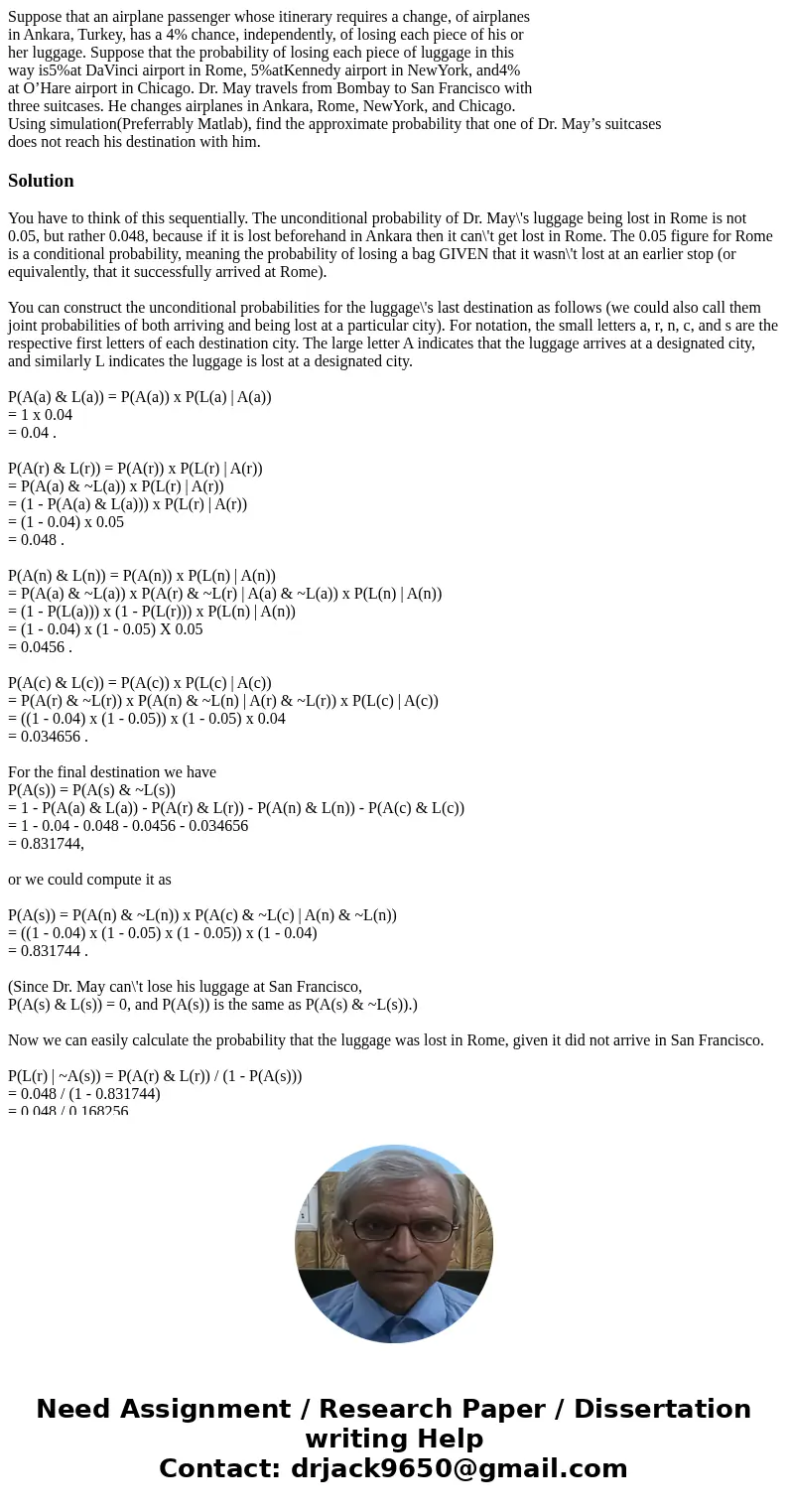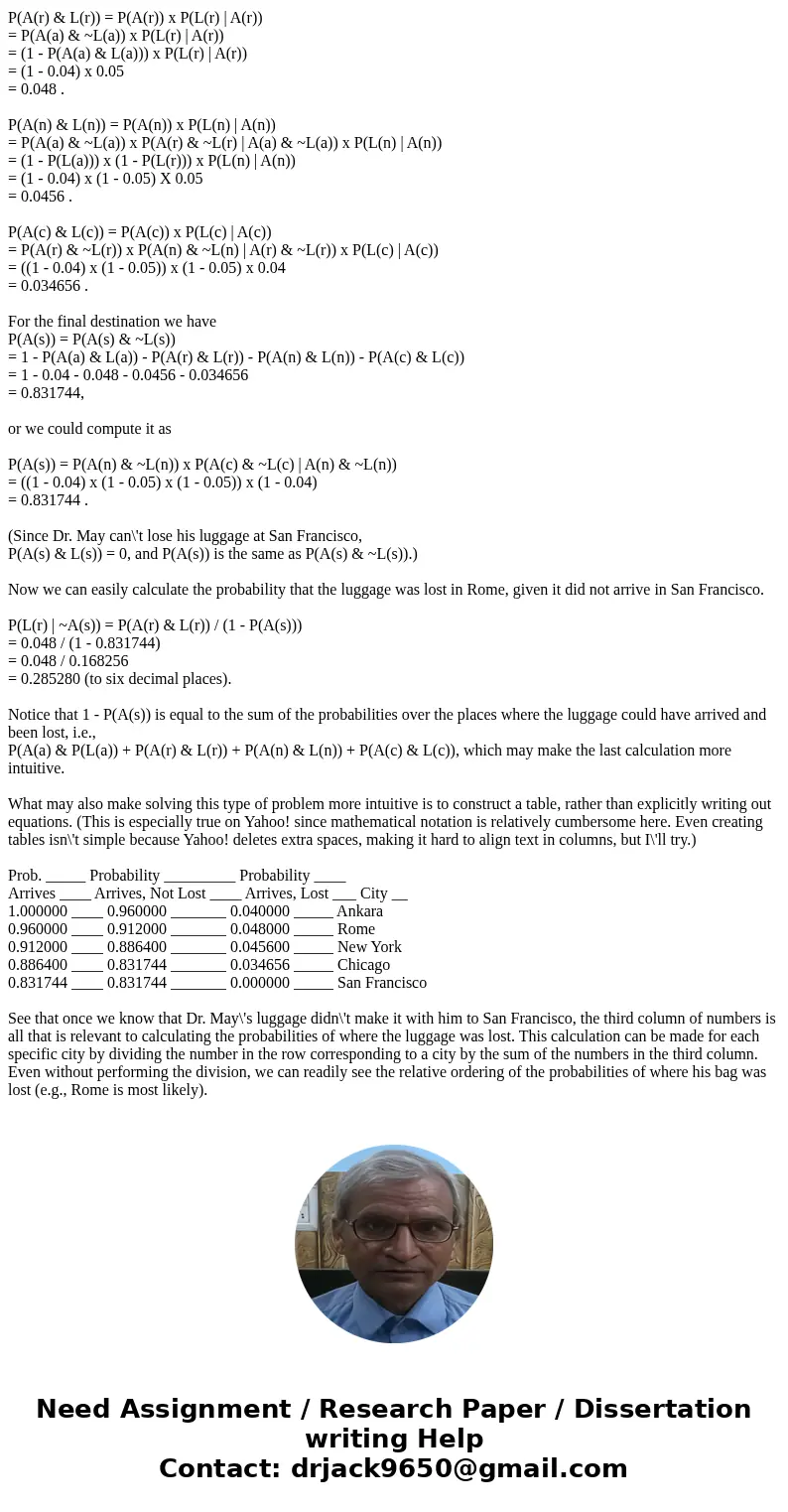Suppose that an airplane passenger whose itinerary requires
Suppose that an airplane passenger whose itinerary requires a change, of airplanes
in Ankara, Turkey, has a 4% chance, independently, of losing each piece of his or
her luggage. Suppose that the probability of losing each piece of luggage in this
way is5%at DaVinci airport in Rome, 5%atKennedy airport in NewYork, and4%
at O’Hare airport in Chicago. Dr. May travels from Bombay to San Francisco with
three suitcases. He changes airplanes in Ankara, Rome, NewYork, and Chicago.
Using simulation(Preferrably Matlab), find the approximate probability that one of Dr. May’s suitcases
does not reach his destination with him.
Solution
You have to think of this sequentially. The unconditional probability of Dr. May\'s luggage being lost in Rome is not 0.05, but rather 0.048, because if it is lost beforehand in Ankara then it can\'t get lost in Rome. The 0.05 figure for Rome is a conditional probability, meaning the probability of losing a bag GIVEN that it wasn\'t lost at an earlier stop (or equivalently, that it successfully arrived at Rome).
You can construct the unconditional probabilities for the luggage\'s last destination as follows (we could also call them joint probabilities of both arriving and being lost at a particular city). For notation, the small letters a, r, n, c, and s are the respective first letters of each destination city. The large letter A indicates that the luggage arrives at a designated city, and similarly L indicates the luggage is lost at a designated city.
P(A(a) & L(a)) = P(A(a)) x P(L(a) | A(a))
= 1 x 0.04
= 0.04 .
P(A(r) & L(r)) = P(A(r)) x P(L(r) | A(r))
= P(A(a) & ~L(a)) x P(L(r) | A(r))
= (1 - P(A(a) & L(a))) x P(L(r) | A(r))
= (1 - 0.04) x 0.05
= 0.048 .
P(A(n) & L(n)) = P(A(n)) x P(L(n) | A(n))
= P(A(a) & ~L(a)) x P(A(r) & ~L(r) | A(a) & ~L(a)) x P(L(n) | A(n))
= (1 - P(L(a))) x (1 - P(L(r))) x P(L(n) | A(n))
= (1 - 0.04) x (1 - 0.05) X 0.05
= 0.0456 .
P(A(c) & L(c)) = P(A(c)) x P(L(c) | A(c))
= P(A(r) & ~L(r)) x P(A(n) & ~L(n) | A(r) & ~L(r)) x P(L(c) | A(c))
= ((1 - 0.04) x (1 - 0.05)) x (1 - 0.05) x 0.04
= 0.034656 .
For the final destination we have
P(A(s)) = P(A(s) & ~L(s))
= 1 - P(A(a) & L(a)) - P(A(r) & L(r)) - P(A(n) & L(n)) - P(A(c) & L(c))
= 1 - 0.04 - 0.048 - 0.0456 - 0.034656
= 0.831744,
or we could compute it as
P(A(s)) = P(A(n) & ~L(n)) x P(A(c) & ~L(c) | A(n) & ~L(n))
= ((1 - 0.04) x (1 - 0.05) x (1 - 0.05)) x (1 - 0.04)
= 0.831744 .
(Since Dr. May can\'t lose his luggage at San Francisco,
P(A(s) & L(s)) = 0, and P(A(s)) is the same as P(A(s) & ~L(s)).)
Now we can easily calculate the probability that the luggage was lost in Rome, given it did not arrive in San Francisco.
P(L(r) | ~A(s)) = P(A(r) & L(r)) / (1 - P(A(s)))
= 0.048 / (1 - 0.831744)
= 0.048 / 0.168256
= 0.285280 (to six decimal places).
Notice that 1 - P(A(s)) is equal to the sum of the probabilities over the places where the luggage could have arrived and been lost, i.e.,
P(A(a) & P(L(a)) + P(A(r) & L(r)) + P(A(n) & L(n)) + P(A(c) & L(c)), which may make the last calculation more intuitive.
What may also make solving this type of problem more intuitive is to construct a table, rather than explicitly writing out equations. (This is especially true on Yahoo! since mathematical notation is relatively cumbersome here. Even creating tables isn\'t simple because Yahoo! deletes extra spaces, making it hard to align text in columns, but I\'ll try.)
Prob. _____ Probability _________ Probability ____
Arrives ____ Arrives, Not Lost ____ Arrives, Lost ___ City __
1.000000 ____ 0.960000 _______ 0.040000 _____ Ankara
0.960000 ____ 0.912000 _______ 0.048000 _____ Rome
0.912000 ____ 0.886400 _______ 0.045600 _____ New York
0.886400 ____ 0.831744 _______ 0.034656 _____ Chicago
0.831744 ____ 0.831744 _______ 0.000000 _____ San Francisco
See that once we know that Dr. May\'s luggage didn\'t make it with him to San Francisco, the third column of numbers is all that is relevant to calculating the probabilities of where the luggage was lost. This calculation can be made for each specific city by dividing the number in the row corresponding to a city by the sum of the numbers in the third column. Even without performing the division, we can readily see the relative ordering of the probabilities of where his bag was lost (e.g., Rome is most likely).


 Homework Sourse
Homework Sourse